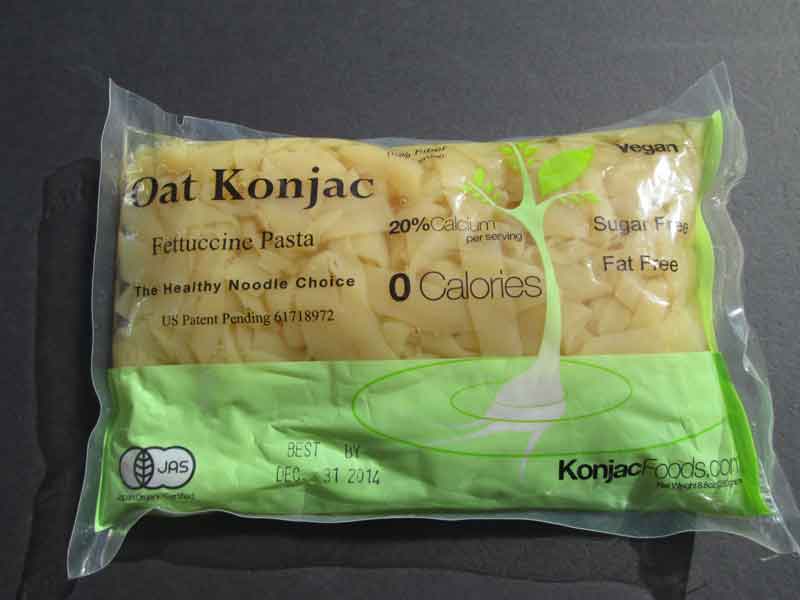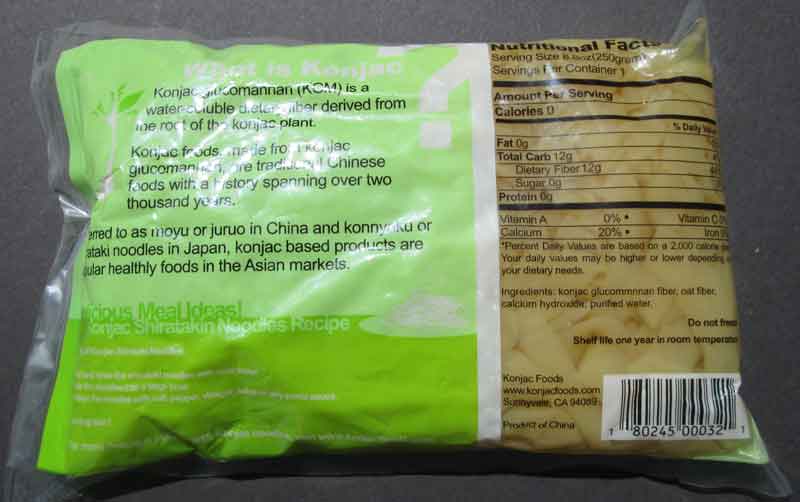|
Konjac
Oat Fettuccine Pasta 8.8oz (250g) net weight per bag



Konjac Oat Noodles
Konjac Oat Noodles, is a patent pending new product from Konjac Foods. Konjac oat noodles have zero calories, and are made with Konjac fiber and oat fiber. Konjac fiber also contains glucomannan, which is a water soluble dietary fiber. The oat fiber ingredient is made in the USA , it is mainly a water insoluble dietary fiber. Konjac oat noodles come in a wet form and are pre-packaged in water.
Traditionally konjac noodles, also known as Shirataki noodles or Konnyaku in Japanese, have zero calories, are transparent and look similar to Chinese glass noodles, however the traditional konjac noodles have a rubbery texture and are sometimes unable to absorb all flavors.
Konjac Foods has been focusing on improving the texture of the noodles, while still maintaining its zero calories. As a result, we have found that by adding oat fiber (made in the USA) it is easier for the noodles to absorb more flavor and the texture is also less rubbery. The oat fiber was able to make the texture of the konjac noodles tamer. The only difference is that the color of these noodles are light brown (due to the oat fiber.)
How They Are Packaged:
Konjac noodles come wet and are packed in little water. You must rinse the konjac noodles with water and then they are ready to eat.
How the Konjac Oat Noodles Taste:
Konjac Oat Noodles don't have a real taste of their own. Although in some cases, when you first open the bag you will notice a slightly fishy odor, but this can be easily washed off. Simply drain and rinse the noodles with cold water and repeat, after a short period of boiling, do a quick rinse with hot water and the smell will be completely gone.
Konjac Oat Noodles are a unique type of pasta, made by blending the konjac fiber and oat fiber flour, and unlike regular pasta, it is calorie free.
When compared to the traditional Konjac Shirataki noodles, Konjac oat pasta looks more like regular noodles with a light brown color (due to the oat fiber), it can easily absorb flavors, and has a less rubbery texture. It's a USA patent pending new food by Konjac Foods.
Konjac Oat Noodles are calorie free, they are easy to cook, simply rinse and drain them, then you may add them to your favorite recipe, either cold or hot.
Made with oat fiber and Konjac (glucomannan) fiber, the Konjac oat noodles contains both soluble fiber Konjac glucomannan and insoluble fiber oat fiber. The oat fiber is zero calories and you can add Konjac oat noodles to your favorite recipes that normally call for pasta.
Konjac Low carb Pasta
Zero Net Carb, Zero Calories, Pure Soluble Fiber
Konjac pasta was made by nature soluble fiber - Konjac
glucomannan (KGM) and water, is very low carb and very low glycemic
nature food, Konjac pasta can be made into many different styles
and shapes such as noodles, all kinds pasta.
Konjac pasta is traditional Japanese foods called shirataki noodles
or konnyaku.
Konjac foods, translucent and gelatinous, have no discernable
taste but absorb the dominant flavors of the soup or dish to which
they're added. Konjac foods have no flavors but absorb any they're
with, like tofu will blend wonderfully and absorb flavors. They're
supposed to absorb tastes of sauces as well.
Konjac foods are white in color, almost transparent and gelatinous,
and package with water filled plastic bags. They consist primarily
of konjac glucomannan soluble fiber, and are very low glycemic,
and therefore especially good for people with diabetes.
According the medical research, Clinical Excellence for Nurse
Practitioners. 2000 Sep;4(5):272-6
Dietary fiber and type 2 diabetes
"Water-soluble fiber appears to have a greater potential to reduce
postprandial blood glucose, insulin, and serum lipid levels than
insoluble fiber. Viscosity of the dietary fiber is important;
the greater the viscosity, the greater the effect."
The konjac glucomanann is the most viscosity soluble fiber in
the nature.
The konjac foods are made of glucomannan soluble fiber, purified
water and calcium hydroxide.
Konjac foods very much like Chinese glass noodles (cellophane
or bean thread noodles) in taste and texture but they have almost
no calories.
Konajc foods come in various shapes besides the noodle shape,
like mini pearl pasta, flat pasta and tube pasta. Konjac foods
packaging with water in plastic bag, After open the plastic bag,
you need drain well the konjac pasta before cooking.
Konjac foods can be stored in room temperature with the shelf
life about one year.
DONOT freeze the konjac pasta
Konjac foods is kinds of instant foods, you can toss it with sauce
like vinegar, soy sauce, pepper, onion or garlic or any flavors
your favored, then just eat it in cold. You can also boil or cook
the konjac pasta with other vegetable, meat or seafood, with any
flavor you favored.
Cooking: dip in water or steam about 3-5 minutes and than cook
in the way you like. You can add various vegetables and meat which
ever you like, it can be fryed, baked,stewed, braised and also
used as a cold dressing with a sauce.
You can cook konjac foods just like regular pasta, while the texture
was bouncier than regular pasta.
Soluble Fiber Intake & Type 2 Diabetes Mellitus: The Research
Research proves that the higher the viscosity of soluble fiber,
the better the control of blood sugar level in patients with Type
2 diabetes:
The
New England Journal of Medicine (May 11, 2000. v342: 1392-1398)
Beneficial effects of high dietary fiber intake in patients
with type 2 diabetes mellitus.
"A high intake of dietary fiber, particularly of the
soluble type, above the level recommended by the ADA, improves
glycemic control, decreases hyperinsulinemia, and lowers plasma
lipid concentrations in patients with type 2 diabetes"
Clin
Excell Nurse Pract.(September 2000; 4 (5): 272-6)
Dietary fiber and type 2 diabetes.
"Water-soluble fiber appears to have a greater potential
to reduce postprandial blood glucose, insulin, and serum lipid
levels than insoluble fiber. Viscosity of the dietary fiber is
important; the greater the viscosity, the greater the effect.
"
Med
Hypotheses. (June 2002; (6): 487-90)
Glucomannan minimizes the postprandial insulin surge: a potential
adjuvant for hepatothermic therapy.
"Glucomannan (GM) is differentiated from other soluble fibers
by the extraordinarily high viscosity of GM solutions. Administration
of 4-5g of GM with meals, blended into fluid or mixed with food,
can slow carbohydrate absorption and dampen the postprandial insulin
response by up to 50%. "
Diabetes
Care (1999 Jun v22, i6; 913-919)
Konjac-mannan (glucomannan) improves glycemia and other associated
risk factors for coronary heart disease in type 2 diabetes. A
randomized controlled metabolic trial.
"KJM fiber added to conventional treatment may ameliorate
glycemic control, blood lipid profile, and SBP in high-risk diabetic
individuals, possibly improving the effectiveness of conventional
treatment in type 2 diabetes"
Diabetes
Care (2000; 23: 9 - 14)
Beneficial effects of viscous dietary fiber from Konjac-mannan
in subjects with the insulin resistance syndrome: results of a
controlled metabolic trial.
"A diet rich in high-viscosity KJM improves glycemic control
and lipid profile, suggesting a therapeutic potential in the treatment
of the insulin resistance syndrome."
Journal
of the American College of Nutrition (2003, February, 22(1): 36-42)
Konjac supplement alleviated hypercholesterolemia and hyperglycemia
in type 2 diabetic subjects--a randomized double-blind trial.
"The KGM supplement improved blood lipid levels by enhancing
fecal excretion of neutral sterol and bile acid and alleviated
the elevated glucose levels in diabetic subjects. KGM could be
an adjunct for the treatment of hyperlipidemic diabetic subjects."
Konjac Foods Recipes
Olive Pasta with Mushrooms and Tomatoes
1/2 pound Konjac Glucomannan pasta
1/4 pound mushrooms, sliced
1/2 cup halved cherry tomatoes
1/2 cup pitted ripe olives
1 tablespoon parsley
1/2 teaspoon dry basil
Drain and rinse Konjac pasta with cold water and drain again.
Place into a large
bowl. Add mushrooms, cherry tomatoes, olives, parsley and basil;
toss gently, season with salt and pepper to taste.
Serving Size: 2
Classic Spiced Konjac Pasta
1/2 pound Konjac Glucomannan pasta
1 tablespoon vinegar
1/2 cup sliced celery
1/2 tablespoon prepared mustard
1/2cup chopped red pepper
1/2 teaspoons salt
1/8 cup chopped onion
1/8 teaspoon pepper
In a large bowl, stir vinegar, mustard, salt and pepper until
smooth. Add Konjac pasta, celery, green pepper and onion. Toss
to coat well. Refrigerate covered for at least two hours to blend
flavors.
Serving Size: 2
Vegetable Konjac Pasta
1/2 pound Konjac Glucomannan pasta
1/2 cup chopped onions
1 medium chopped tomato
1/4 cup chopped bell pepper
1/8 cup olive oil
1/8 cup lemon juice
1 teaspoon garlic powder
1/4 teaspoon oregano
1/4 teaspoon basil
1/4 teaspoon thyme
1/4 teaspoon salt
Gently mix all ingredients in a large mixing bowl. Refrigerate
until cold, allowing the mixture to set for an hour before serving
to enhance the flavor before serving.
Serving Size: 1
Pepper Konjac Pasta
1 pound Konjac Glucomannan pasta
1 hard boiled egg, chopped
1/2 green pepper, chopped
1/2 red pepper, chopped
2 fresh tomatoes, chopped
4 tablespoon olive oil
4 tablespoon vinegar
Drain and rinse the Konjac pasta well. Add the oil and vinegar,
mixing well. Add all
other ingredients and mix well. Then salt and pepper to taste.
Serving Size: 1
Olive Konjac Pasta
1/2 pound Konjac Glucomannan pasta
1 1/2 tablespoons olive oil
1 tablespoon wine vinegar
4 or 5 olives -- pitted and quartered
1/2 teaspoon dried oregano
Freshly ground pepper -- to taste
Drain and rinse Konjac pasta with cold water. Transfer to a
mixing bowl and toss immediately with the olive oil. Add vinegar
and toss again. Add the olives, oregano, and pepper. Toss again.
Serving Size: 2
Italian Konjac Pasta
1 pound Konjac Glucomannan pasta
1/2 teaspoon olive oil
1/2 cucumber, diced
1/2 bell pepper, chopped
1 whole tomatoes, diced
9oz can tomato sauce
4oz Italian dressing
Drain and rinse Konjac pasta with cold water, then drain and
add olive oil.
Add remaining ingredients. Add onion and red wine vinegar to taste.
Serving Size: 2
Konjac Garlic Pasta
1/2 pound Konjac Glucomannan pasta
4 large tomatoes, quartered
1 red bell pepper, sliced
8 black olives
4 tablespoon olive oil
2 tablespoon white vinegar
2 garlic cloves, chopped
Drain & rinse Konjac pasta under cold water. Set aside.
In a large bowl, mix together the Konjac pasta, bell pepper, tomatoes,
and beans; add the olives & capers. Mix the oil, vinegar,
garlic, salt &
pepper. Pour over the Konjac pasta and salt & pepper to taste.
Toss well just before serving.
Serving Size: 4
Konjac Pasta Primavera
1/2 pound Konjac Glucomannan pasta
2 cups broccoli florets
1 cups sliced carrots
1 cups cherry tomatoes, quartered
1/4 cups sliced red onions
8oz ranch dressing
Drain and rinse Konjac pasta. Add vegetables and dressing to
the pasta.
Refrigerate several hours before serving.
Serving Size: 1
Balsamic Konjac Pasta
1 pound Konjac Glucomannan pasta
1 cup peeled & chopped tomatoes
2 teaspoon balsamic vinegar
1/4 cup minced red onions
2 teaspoon olive oil
2 tablespoons minced fresh basil
1/8 teaspoons ground black pepper
2 garlic cloves, minced
Drain and rinse Konjac pasta with cold water, drain again.
Combine all ingredients in a glass bowl. Cover & let stand
at room temperature for 1 hour. Fold in the Konjac pasta just
before serving
Serving Size: 4
Konjac Pasta with Peppers
1 pound Konjac Glucomannan pasta
4 tomatoes, chopped
1 green pepper, cubed
1 yellow pepper, cubed
1/2 hot pepper, chopped
3 tablespoons olive oil
3 tablespoon red wine vinegar
1 clove garlic, minced
2 tablespoons chopped parsley
1 tablespoon chili powder
2 tablespoons sunflower seeds
Drain and rinse Konjac pasta with cold water, and drain again
Combine vegetables in large bowl. Combine oil, vinegar, garlic,
parsley, chili powder, salt & pepper to taste. Pour over vegetable
mixture.
Stir in Konjac pasta, sprinkle with sunflower seeds and toss.
Chill.
Serving Size: 1
|